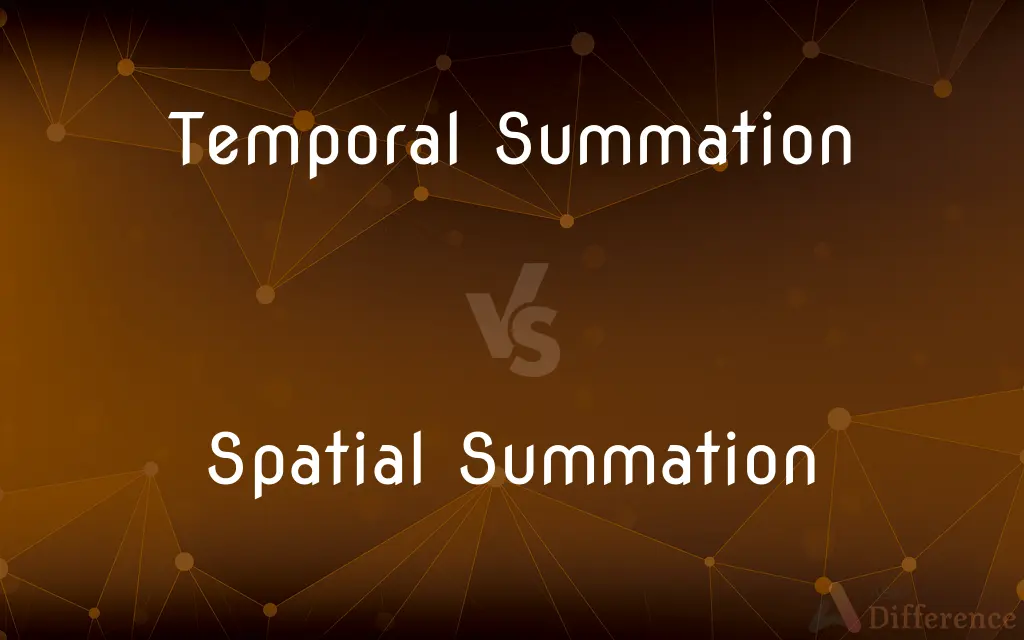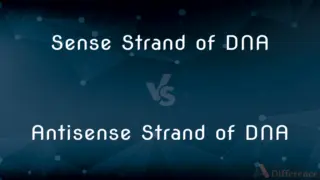Temporal Summation vs. Spatial Summation — What's the Difference?
By Tayyaba Rehman — Published on December 12, 2023
Temporal Summation: Accumulation of successive neural signals in a short time. Spatial Summation: Combining of signals from different neuron sources.

Difference Between Temporal Summation and Spatial Summation
Table of Contents
ADVERTISEMENT
Key Differences
Temporal Summation refers to the phenomenon where a single neuron receives multiple signals from a singular presynaptic neuron in quick succession. If these signals are frequent enough, they can collectively bring the postsynaptic neuron to threshold, resulting in an action potential. On the other hand, Spatial Summation is when a single postsynaptic neuron is stimulated by multiple presynaptic neurons at once. If the collective signals from these numerous sources reach a certain threshold, they can cause the postsynaptic neuron to fire.
In the realm of neural physiology, Temporal Summation is crucial because it exemplifies how repeated stimuli can generate an amplified response in neurons. This frequency-based response can lead to the formation of memories or conditioned responses. Spatial Summation, conversely, showcases the importance of a neuron's location and its connections. Multiple sources sending signals simultaneously can lead to a powerful collective response, underlying the integrative capacity of neural networks.
To visualize Temporal Summation, imagine a single drummer tapping a drum repeatedly. If he taps rapidly enough, the sound may reverberate and amplify. For Spatial Summation, envision an ensemble of drummers each hitting their drum once, but at the exact same time, producing a loud, singular beat. Both concepts, Temporal Summation and Spatial Summation, are fundamental in understanding how neurons integrate information and produce coordinated responses.
At a deeper level, Temporal Summation and Spatial Summation highlight the intricacies of neuronal communication. Temporal Summation emphasizes the time aspect, showcasing how frequency can influence the neural response. Spatial Summation underscores the spatial aspect, illustrating how the collective input from various sources can influence a singular response.
Comparison Chart
Type of Input
Multiple signals from one source in rapid succession.
Signals from multiple sources at once.
ADVERTISEMENT
Emphasis
Time (Frequency of signals).
Space (Location and number of sources).
Integration Principle
Successive neural signals combine over short time.
Neural signals from different sources combine.
Visualization
Single drummer tapping repeatedly.
Multiple drummers hitting once, simultaneously.
Relevance
Frequency-based neural responses.
Integrative capacity of neural networks.
Compare with Definitions
Temporal Summation
Accumulation of successive signals in a neuron over a short period.
Memory formation can involve Temporal Summation as neurons process repeated stimuli.
Spatial Summation
Combining of inputs across different neuron origins.
Multiple neural pathways contributed through Spatial Summation to generate a singular response.
Temporal Summation
Time-based integration of neural inputs.
Through Temporal Summation, the neuron fired an action potential after multiple quick signals.
Spatial Summation
Geographical-based merging of neural inputs.
Through Spatial Summation, the neuron assessed inputs from various connecting neurons.
Temporal Summation
Frequency-based aggregation of neural signals.
The rapid flashes of light resulted in Temporal Summation, leading to a sustained neural response.
Spatial Summation
Aggregation of simultaneous stimuli from different locations.
The brain's integration capacity is exemplified by Spatial Summation of diverse neural inputs.
Temporal Summation
Consecutive stimuli causing a magnified neuronal response.
Temporal Summation allowed the neuron to reach the threshold with the repeated, fast-paced inputs.
Spatial Summation
Collective influence of various neural signals on a single neuron.
Spatial Summation led to the neuron's action potential due to simultaneous signals.
Temporal Summation
Neural response amplification due to rapid repeated signals.
Temporal Summation was evident as the neuron's activity increased with successive stimuli.
Spatial Summation
Integration of signals from multiple neuron sources.
The neuron fired due to Spatial Summation from multiple presynaptic inputs.
Common Curiosities
Why is Temporal Summation important in neural physiology?
It shows how repeated stimuli can amplify a neural response, affecting memory and conditioned responses.
What is the primary difference between Temporal Summation and Spatial Summation?
Temporal Summation focuses on frequency of signals from one source, while Spatial Summation involves signals from multiple sources.
How does Temporal Summation relate to time?
It emphasizes the rapid succession of neural signals over a short period.
Can Temporal Summation and Spatial Summation occur simultaneously?
Yes, a neuron can integrate signals based on both frequency (temporal) and multiple sources (spatial).
Does Temporal Summation require one or multiple presynaptic neurons?
It typically involves repeated signals from a singular presynaptic neuron.
How does Temporal Summation influence action potentials in postsynaptic neurons?
If signals are frequent enough, they can collectively cause the neuron to fire an action potential.
Are there practical applications of understanding Spatial Summation?
Yes, understanding Spatial Summation can aid in neural network designs and studying brain functions.
What is the significance of location in Spatial Summation?
Spatial Summation highlights the collective input from neurons based on their location and connections.
Can a lack of Temporal Summation affect memory formation?
Yes, frequency-based responses influence memory, and a lack can affect memory encoding.
What role does Spatial Summation play in sensory perception?
It helps integrate information from various sensory inputs to generate a coherent perception.
For Spatial Summation, can the signals be spread out over time?
Typically, Spatial Summation involves simultaneous signals from different neurons.
How does Spatial Summation demonstrate the integrative capacity of neural networks?
It showcases how various inputs can converge on a single neuron, leading to a collective response.
How is Temporal Summation related to neural threshold?
Repeated signals can collectively bring a neuron to its threshold, causing it to fire.
Do all neurons participate in Spatial Summation?
Not all, but many neurons have the capacity for Spatial Summation due to their multiple connections.
Can an understanding of Temporal Summation and Spatial Summation aid in neurological treatments?
Yes, it can guide therapies targeting neural responsiveness and integration.
Share Your Discovery

Previous Comparison
Sense Strand of DNA vs. Antisense Strand of DNA
Next Comparison
Acidic Oxides vs. Basic OxidesAuthor Spotlight
Written by
Tayyaba RehmanTayyaba Rehman is a distinguished writer, currently serving as a primary contributor to askdifference.com. As a researcher in semantics and etymology, Tayyaba's passion for the complexity of languages and their distinctions has found a perfect home on the platform. Tayyaba delves into the intricacies of language, distinguishing between commonly confused words and phrases, thereby providing clarity for readers worldwide.












































